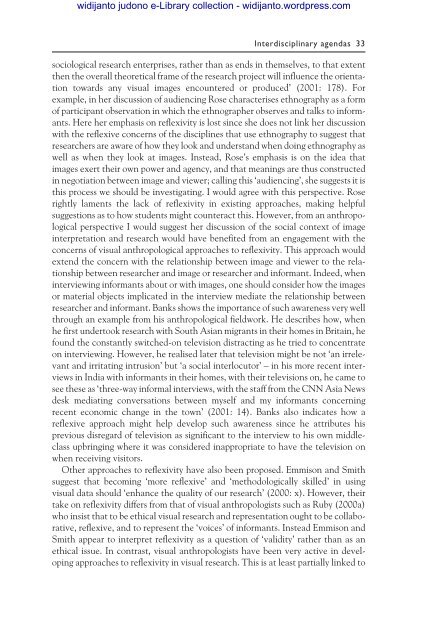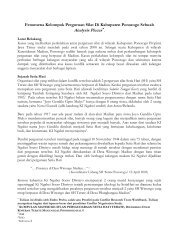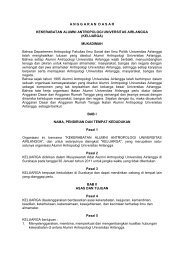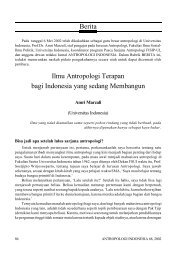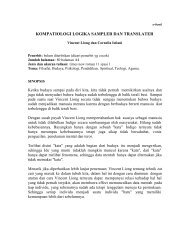The Future of Visual Anthropology: Engaging the Senses
The Future of Visual Anthropology: Engaging the Senses
The Future of Visual Anthropology: Engaging the Senses
You also want an ePaper? Increase the reach of your titles
YUMPU automatically turns print PDFs into web optimized ePapers that Google loves.
widijanto judono e-Library collection - widijanto.wordpress.com<br />
Interdisciplinary agendas 33<br />
sociological research enterprises, ra<strong>the</strong>r than as ends in <strong>the</strong>mselves, to that extent<br />
<strong>the</strong>n <strong>the</strong> overall <strong>the</strong>oretical frame <strong>of</strong> <strong>the</strong> research project will influence <strong>the</strong> orientation<br />
towards any visual images encountered or produced’ (2001: 178). For<br />
example, in her discussion <strong>of</strong> audiencing Rose characterises ethnography as a form<br />
<strong>of</strong> participant observation in which <strong>the</strong> ethnographer observes and talks to informants.<br />
Here her emphasis on reflexivity is lost since she does not link her discussion<br />
with <strong>the</strong> reflexive concerns <strong>of</strong> <strong>the</strong> disciplines that use ethnography to suggest that<br />
researchers are aware <strong>of</strong> how <strong>the</strong>y look and understand when doing ethnography as<br />
well as when <strong>the</strong>y look at images. Instead, Rose’s emphasis is on <strong>the</strong> idea that<br />
images exert <strong>the</strong>ir own power and agency, and that meanings are thus constructed<br />
in negotiation between image and viewer; calling this ‘audiencing’, she suggests it is<br />
this process we should be investigating. I would agree with this perspective. Rose<br />
rightly laments <strong>the</strong> lack <strong>of</strong> reflexivity in existing approaches, making helpful<br />
suggestions as to how students might counteract this. However, from an anthropological<br />
perspective I would suggest her discussion <strong>of</strong> <strong>the</strong> social context <strong>of</strong> image<br />
interpretation and research would have benefited from an engagement with <strong>the</strong><br />
concerns <strong>of</strong> visual anthropological approaches to reflexivity. This approach would<br />
extend <strong>the</strong> concern with <strong>the</strong> relationship between image and viewer to <strong>the</strong> relationship<br />
between researcher and image or researcher and informant. Indeed, when<br />
interviewing informants about or with images, one should consider how <strong>the</strong> images<br />
or material objects implicated in <strong>the</strong> interview mediate <strong>the</strong> relationship between<br />
researcher and informant. Banks shows <strong>the</strong> importance <strong>of</strong> such awareness very well<br />
through an example from his anthropological fieldwork. He describes how, when<br />
he first undertook research with South Asian migrants in <strong>the</strong>ir homes in Britain, he<br />
found <strong>the</strong> constantly switched-on television distracting as he tried to concentrate<br />
on interviewing. However, he realised later that television might be not ‘an irrelevant<br />
and irritating intrusion’ but ‘a social interlocutor’ – in his more recent interviews<br />
in India with informants in <strong>the</strong>ir homes, with <strong>the</strong>ir televisions on, he came to<br />
see <strong>the</strong>se as ‘three-way informal interviews, with <strong>the</strong> staff from <strong>the</strong> CNN Asia News<br />
desk mediating conversations between myself and my informants concerning<br />
recent economic change in <strong>the</strong> town’ (2001: 14). Banks also indicates how a<br />
reflexive approach might help develop such awareness since he attributes his<br />
previous disregard <strong>of</strong> television as significant to <strong>the</strong> interview to his own middleclass<br />
upbringing where it was considered inappropriate to have <strong>the</strong> television on<br />
when receiving visitors.<br />
O<strong>the</strong>r approaches to reflexivity have also been proposed. Emmison and Smith<br />
suggest that becoming ‘more reflexive’ and ‘methodologically skilled’ in using<br />
visual data should ‘enhance <strong>the</strong> quality <strong>of</strong> our research’ (2000: x). However, <strong>the</strong>ir<br />
take on reflexivity differs from that <strong>of</strong> visual anthropologists such as Ruby (2000a)<br />
who insist that to be ethical visual research and representation ought to be collaborative,<br />
reflexive, and to represent <strong>the</strong> ‘voices’ <strong>of</strong> informants. Instead Emmison and<br />
Smith appear to interpret reflexivity as a question <strong>of</strong> ‘validity’ ra<strong>the</strong>r than as an<br />
ethical issue. In contrast, visual anthropologists have been very active in developing<br />
approaches to reflexivity in visual research. This is at least partially linked to


